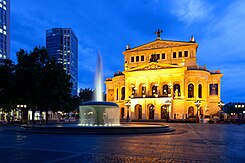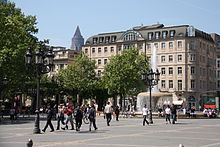Opernplatz (Frankfurt am Main)
| Opera Square | |
|---|---|
| Place in Frankfurt am Main | |
 Old Opera, Opera Square and Lucae Fountain |
|
| Basic data | |
| place | Frankfurt am Main |
| District | Downtown |
| Confluent streets | Goethestrasse , Freßgass , Neue Mainzer Strasse, Hochstrasse, Taunusanlage , Bockenheimer Landstrasse |
| Buildings | Old Opera , Zurich House (†), Opera Tower |
The Opernplatz is a square in the north-western inner city of Frankfurt am Main .
history
There was once a city gate within the Frankfurt city fortifications at this point . The Bockenheimer Tor and the Bockenheimer Landstrasse connected to it led through the Frankfurt district to the town of Bockenheim . In the Middle Ages , the town, which was incorporated in 1895, was outside the Frankfurter Landwehr , which enclosed the district. From the Bockenheimer highway that went just after the gate Mainzer Landstrasse in a southwesterly direction. After the city walls had been razed around the city center, today's Opernplatz was located between the Taunus and Bockenheimer grounds . City architect Johann Georg Christian Hess had a classical portal built there, which was supposed to emphasize the medieval importance of the square. However, the portal was torn down again in 1875 to make room for an opera house. The house known today as the Alte Oper was completed in 1880 and was one of the largest of its time. At first only part of the square surrounding the opera was called Opernplatz ; the actual Bockenheimer Tor, which was in front of the main entrance, initially retained its name. Today's Frankfurt Opera is located on Willy-Brandt-Platz - sometimes irritating for guests from outside .
building
The eponymous building on the square is the Alte Oper . The opera house, built in 1880, was badly damaged in the air raids on Frankfurt am Main during World War II and was only able to reopen as a concert hall in 1981 . The building, known for years as “ Germany's most beautiful ruin ”, also shaped the square during this time.
In addition, the Zurich House , one of the first skyscrapers in the city, existed until 2002 on the opposite side of the street on Bockenheimer Landstrasse . Built in 1960 by the Zurich Insurance Group , the skyscraper was 68 meters high, which was only exceeded by the Shell skyscraper in 1966 . In 2002 the owner had the listed building demolished. In 2004 the area was sold to the US real estate company Tishman Speyer Properties , which had the Opera Tower built here from the beginning of 2007 to 2010 .
The east side of the square, along the Hochstrasse , is built on six-story historicist commercial buildings. The adjacent post-war buildings are to be demolished and replaced by a five-star-plus hotel (architects: Braun & Schlockermann; start of construction: 2011; opening: 2014).
Lucae fountain
The fountain on Opernplatz was designed in 1872 by the architect Richard Lucae (1829–1877) and was originally intended for the Rahmhof (near Schillerstrasse). It was not until a good 100 years later, in 1983, that the fountain was made by the sculptor Edwin Hüller based on Lucae's sketch . On June 14, 1983, the fountain made of 120 tons of noble yellow Reinersreuther granite was inaugurated with a community festival. The pool of the fountain, which is also used for splashing around when the weather is fine, has a diameter of 17 m, the bowl measures 5 m in diameter and is 3.20 m high.
gallery
Opera tower and old opera
View from the Main Tower to the Alte Oper and Opernplatz
Confluent streets
Seven streets lead into Opernplatz:
- Intra Muros
- the Goethe street , an exclusive shopping street;
- the Große Bockenheimer Straße , better known as Freßgass
- in the course of the former fortification
- the Neue Mainzer Straße (southeast), main road to the financial district ;
- the elevated road (northeast), here bends to the east;
- the Bockenheimer plant (northwest)
- the Taunusanlage (southwest), here former part of the Mainzer Landstrasse ;
- Extra muros
Subway station
The Alte Oper underground station is located below the square . It was opened as part of the C-route of the Frankfurt U-Bahn in 1986 and has remained unchanged to this day. The subway station is designed in a postmodern style and is the only one in the Frankfurt subway network that has no load-bearing ceiling supports. The ceiling and wall design takes up motifs from the neighboring Alte Oper.
Further east opens the subway - track and the center distance of the train in a common four-track tunnel , to the Friedberg plant under the Zeil runs.
Web links
Individual evidence
- ^ Alte Oper Frankfurt ( Memento from February 16, 2011 in the Internet Archive )
- ↑ http://www.kunst-im-oefflichen-raum-frankfurt.de/de/page97.html?id=77&kuenstler=57
Coordinates: 50 ° 6 ′ 55 ″ N , 8 ° 40 ′ 17 ″ E
















